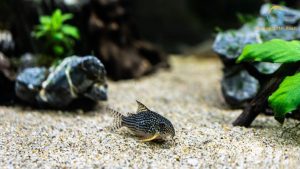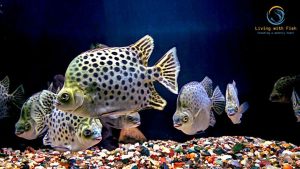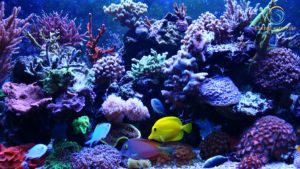This article covers the following areas –
- 1. Betta Fish
- 2. Zebra Danios
- 3. Guppies
- 4. Platies
- 5. Cherry Barbs
- 6. Black Molly
- 7. Swordtails
- 8. Harlequin Rasboras
- 9. Corydoras Catfish
- 10. Neon Tetras
- In Conclusion
- FAQs: Hardy Freshwater Fish for Beginners: A Selection Guide
As a beginner in the world of fishkeeping, it can be overwhelming to choose the perfect fish for your new aquarium. Some fish require much care and attention, making them less suitable for beginners. In this article, I’ll discuss the top 10 hardy freshwater fish that are perfect for beginners.
The table below summarizes the key information for each of the top 10 hardy freshwater fish for beginners.
| Fish Name | Minimum Tank Size | Temperature Range (°F) | pH Range | Schooling Fish |
|---|---|---|---|---|
| Betta Fish | 5 gallons | 76-82 | 6.5-7.5 | No |
| Zebra Danios | 10 gallons | 64-75 | 6.5-8.0 | Yes |
| Guppies | 10 gallons | 74-82 | 6.8-7.8 | No |
| Platies | 10 gallons | 72-78 | 7.0-8.0 | No |
| Cherry Barbs | 20 gallons | 73-81 | 6.0-8.0 | Yes |
| Black Molly | 20 gallons | 72-78 | 7.5-8.5 | No |
| Swordtails | 15 gallons | 72-82 | 7.0-8.0 | No |
| Harlequin Rasboras | 10 gallons | 72-81 | 6.0-7.5 | Yes |
| Corydoras Catfish | 20 gallons | 72-78 | 6.0-7.5 | Yes |
| Neon Tetras | 10 gallons | 70-81 | 5.5-7.0 | Yes |
This table provides a helpful summary of the top 10 hardy freshwater fish for beginners, including their minimum tank size, temperature range, pH range, and whether they are schooling fish. Use this information as a reference when selecting fish for your new aquarium. Now, let’s dive into some more details about each fish.
1. Betta Fish

Scientific name: Betta splendens
Betta fish, also known as Siamese fighting fish, are a popular choice for beginners due to their stunning appearance and low-maintenance nature. They are small, brightly colored fish with flowing fins, which make them a captivating addition to any aquarium.
Bettas are labyrinth fish, possessing a unique organ that allows them to breathe air from the surface. This trait enables them to survive in low-oxygen environments, such as rice paddies and shallow ponds in their native Southeast Asia. As a result, betta fish are less demanding regarding water quality and oxygenation, making them ideal for novice fishkeepers.
Despite their beauty, betta fish are territorial, especially among males. They can become aggressive towards other bettas or fish with similar appearances. It’s best to house a single betta fish in a tank or choose peaceful tank mates that won’t provoke aggression. Suitable companions include small, fast-moving fish and bottom-dwellers that won’t intrude on the betta’s territory.
Betta fish are carnivorous and require a diet rich in protein. High-quality betta-specific pellets, as well as occasional treats of live or frozen brine shrimp, daphnia, or bloodworms, will ensure your betta receives the necessary nutrients.
When setting up an aquarium for a betta fish, provide ample hiding spots using decorations or live plants, like java fern or anubias. Bettas appreciate having places to hide and explore, which can help reduce stress and promote overall well-being. It’s also essential to maintain stable water conditions, as sudden changes in temperature or pH can cause stress and illness.
- Minimum tank size: 5 gallons
- Temperature range: 76-82°F
- pH range: 6.5-7.5
2. Zebra Danios

Scientific name: Danio rerio
Zebra danios are small, active fish that make an excellent addition to a beginner’s aquarium. They are hardy, adaptable, and can tolerate various water conditions. Native to South Asia, zebra danios have a striking striped pattern, which gives them their name.
As schooling fish, zebra danios should be kept in groups of at least six to feel secure and display their natural behavior. They are very active swimmers and will spend most of their time in the middle to upper levels of the tank. Because of their high energy levels, they require a spacious aquarium with ample swimming space.
Zebra danios are omnivorous and will accept a wide variety of foods. A diet consisting of high-quality flakes or pellets, supplemented with live or frozen foods such as daphnia, brine shrimp, or bloodworms, will ensure they receive the proper nutrition.
To create a comfortable environment for zebra danios, incorporate live plants and hiding spots in the aquarium. They will also appreciate a gentle water current, which can be achieved with a filter or air stone. Keep the water temperature and pH within the recommended range to maintain their health.
- Minimum tank size: 10 gallons
- Temperature range: 64-75°F
- pH range: 6.5-8.0
3. Guppies

Scientific name: Poecilia reticulata
Guppies are small, colorful fish that are perfect for beginners due to their hardiness and ease of care. They are native to South America and are known for their vibrant colors and patterns, which make them a popular choice for community tanks.
Guppies are livebearers, which means they give birth to live young instead of laying eggs. They are prolific breeders, so if you plan to keep both males and females, be prepared for a rapidly growing population. To control breeding, consider keeping only males, which are more colorful than females.
Guppies are not schooling fish, but they do enjoy the company of their own kind. Keeping them in small groups will encourage social behavior and reduce stress. They are generally peaceful and can coexist with other non-aggressive species in a community tank.
Feeding guppies is straightforward, as they are omnivorous and will accept various foods. A diet of high-quality flakes or pellets, supplemented with occasional live or frozen foods such as brine shrimp or daphnia, will keep them healthy and vibrant.
When setting up a tank for guppies, include live plants and decorations to create hiding spots and territories. Maintain stable water conditions and monitor the temperature and pH to ensure their well-being.
- Minimum tank size: 10 gallons
- Temperature range: 74-82°F
- pH range: 6.8-7.8
4. Platies

Scientific name: Xiphophorus maculatus
Platies are small, colorful, and hardy fish, making them an excellent choice for beginners. They are native to Central America and come in various colors and patterns, which can add a splash of vibrancy to any aquarium.
Like guppies, platies are livebearers, giving birth to live young. They can breed quickly, so be prepared for population growth if you keep both males and females. To control breeding, consider keeping only one gender or providing plenty of hiding spots for the fry to escape predation.
Platies are peaceful fish that can coexist with other non-aggressive species in a community tank. They are not schooling fish but do appreciate the company of their own kind. Keeping them in small groups will promote social behavior and reduce stress.
Feeding platies is simple, as they are omnivorous and accept various foods. Provide them with a balanced diet of high-quality flakes or pellets, supplemented with occasional live or frozen foods such as brine shrimp or daphnia.
To create a comfortable environment for platies, include live plants, decorations, and hiding spots in the tank. Keep the water temperature and pH within the recommended range to maintain their health.
- Minimum tank size: 10 gallons
- Temperature range: 72-78°F
- pH range: 7.0-8.0
5. Cherry Barbs

Scientific name: Puntius titteya
Cherry barbs are small, attractive fish native to Sri Lanka, known for their bright red coloration in males and more subdued shades in females. Their peaceful nature, adaptability, and hardiness make them an excellent choice for novice aquarists.
Cherry barbs are schooling fish and should be kept in groups of at least six to feel secure and display their natural behavior. They are active swimmers and will spend most of their time in the middle to lower levels of the tank. A spacious aquarium with ample swimming space is essential for their well-being.
These fish are omnivorous and will readily accept a wide range of foods. Feed them a balanced diet of high-quality flakes or pellets supplemented with live or frozen foods such as brine shrimp, daphnia, or bloodworms.
To create a comfortable environment for cherry barbs, incorporate live plants, driftwood, and hiding spots in the aquarium. They appreciate a densely planted tank that mimics their natural habitat. Maintain stable water conditions and keep the temperature and pH within the recommended range.
- Minimum tank size: 20 gallons
- Temperature range: 73-81°F
- pH range: 6.0-8.0
6. Black Molly

Scientific name: Poecilia sphenops
Black mollies are popular freshwater fish known for their solid black color and hardiness. They are native to Central and South America and are well-suited for beginner fishkeepers due to their adaptability to various water conditions. You may follow this care guide to ensure a happy and healthy Molly tank.
Black mollies are livebearers, giving birth to live young instead of laying eggs. They breed readily, so be prepared for population growth if you keep both males and females. To control breeding, consider keeping only one gender or providing ample hiding spots for fry to escape predation.
These fish are generally peaceful and can coexist with other non-aggressive species in a community tank. They are not schooling fish but do appreciate the company of their own kind. Keeping them in small groups will encourage social behavior and reduce stress.
Black mollies are omnivorous and will accept a wide variety of foods. Feed them a balanced diet of high-quality flakes or pellets, supplemented with occasional live or frozen foods such as brine shrimp, daphnia, or bloodworms.
When setting up a tank for black mollies, include live plants, decorations, and hiding spots to create a comfortable environment. Maintain stable water conditions and monitor the temperature and pH to ensure their well-being.
- Minimum tank size: 20 gallons
- Temperature range: 72-78°F
- pH range: 7.5-8.5
7. Swordtails

Scientific name: Xiphophorus helleri
Swordtails are a popular and hardy freshwater fish known for their elongated, sword-like tails in males. They are native to Central America and come in various colors, including green, red, and orange. Swordtails are an excellent choice for beginners due to their adaptability and easy care requirements.
Like platies and guppies, swordtails are livebearers and can breed quickly. If you plan to keep both males and females, be prepared for population growth. To control breeding, consider keeping only one gender or providing hiding spots for the fry to escape predation.
Swordtails are peaceful fish that can coexist with other non-aggressive species in a community tank. They are not schooling fish but do appreciate the company of their own kind. Keeping them in small groups will encourage social behavior and reduce stress.
Feeding swordtails is straightforward, as they are omnivorous and will accept various foods. A diet of high-quality flakes or pellets, supplemented with occasional live or frozen foods such as brine shrimp or daphnia, will keep them healthy and vibrant.
When setting up a tank for swordtails, include live plants and decorations to create hiding spots and territories. Maintain stable water conditions and monitor the temperature and pH to ensure their well-being.
- Minimum tank size: 15 gallons
- Temperature range: 72-82°F
- pH range: 7.0-8.0
8. Harlequin Rasboras

Scientific name: Trigonostigma heteromorpha
Harlequin rasboras are small, colorful fish native to Southeast Asia. They are known for their distinct black triangular patch on their bodies and their peaceful nature. Their hardiness and adaptability make them an excellent choice for novice aquarists.
Harlequin rasboras are schooling fish and should be kept in groups of at least six to feel secure and exhibit their natural behavior. They are active swimmers and will spend most of their time in the middle to upper levels of the tank. A spacious aquarium with ample swimming space is essential for their well-being.
These fish are omnivorous and will readily accept a wide range of foods. Feed them a balanced diet of high-quality flakes or pellets supplemented with live or frozen foods such as brine shrimp, daphnia, or bloodworms.
To create a comfortable environment for harlequin rasboras, incorporate live plants, driftwood, and hiding spots in the aquarium. They appreciate a densely planted tank that mimics their natural habitat. Maintain stable water conditions and keep the temperature and pH within the recommended range.
- Minimum tank size: 10 gallons
- Temperature range: 72-81°F
- pH range: 6.0-7.5
9. Corydoras Catfish

Scientific name: Corydoras sp.
Corydoras catfish, also known as Cory cats, are small, bottom-dwelling fish native to South America. They are peaceful and hardy, making them an excellent choice for beginners. Corydoras come in a wide variety of species, each with its unique coloration and patterns.
Corydoras are schooling fish and should be kept in groups of at least six to feel secure and display their natural behavior. They are active scavengers and will help keep the tank clean by consuming leftover food and algae.
These catfish are omnivorous and will accept a wide range of foods. Feed them a balanced diet of sinking pellets, supplemented with occasional live or frozen foods such as brine shrimp, daphnia, or bloodworms.
To create a comfortable environment for Corydoras catfish, including live plants, driftwood, and hiding spots in the aquarium. They prefer a soft, sandy substrate, as they often burrow and sift through it for food. Maintain stable water conditions and keep the temperature and pH within the recommended range.
- Minimum tank size: 20 gallons
- Temperature range: 72-78°F
- pH range: 6.0-7.5
10. Neon Tetras

Scientific name: Paracheirodon innesi
Neon tetras are small, brightly colored fish native to South America. They are known for their vibrant blue and red stripes, which make them a popular choice for aquarists of all experience levels. Neon tetras are peaceful, hardy, and easy to care for, making them an excellent choice for beginners.
Neon tetras are schooling fish and should be kept in groups of at least six to feel secure and display their natural behavior. They are active swimmers and will spend most of their time in the middle to upper levels of the tank.
These fish are omnivorous and will readily accept a wide range of foods. Feed them a balanced diet of high-quality flakes or pellets supplemented with live or frozen foods such as brine shrimp, daphnia, or bloodworms.
To create a comfortable environment for neon tetras, incorporate live plants, driftwood, and hiding spots in the aquarium. They appreciate a densely planted tank with areas of dim lighting, which mimics their natural habitat. Maintain stable water conditions and keep the temperature and pH within the recommended range.
- Minimum tank size: 10 gallons
- Temperature range: 70-81°F
- pH range: 5.5-7.0
In Conclusion
I believe this selection guide will help choose the perfect fish for your new aquarium. Remember that each fish has its unique care requirements, so it’s essential to research each species before adding them to your tank.
By starting with these hardy fish, you’ll be well on your way to a successful and enjoyable fishkeeping experience. And yes! Don’t forget to share your thoughts, questions, and experiences in the comments below!
Happy fish-keeping!
FAQs: Hardy Freshwater Fish for Beginners: A Selection Guide
1. Why are hardy fish recommended for beginners?
Hardy fish are resilient and can tolerate a range of water conditions, making them less susceptible to diseases and stress. This characteristic provides a safety buffer for beginners who might not yet have perfected fishkeeping techniques.
2. Can different species of hardy fish be kept together in one tank?
Yes, many hardy fish species are peaceful and can coexist with other species. However, it’s vital to research each fish’s temperament and requirements to ensure a harmonious tank environment.
3. What are some examples of hardy fish suitable for beginners?
Guppies, tetras, zebrafish, and mollies are some popular choices for beginners due to their hardiness and vibrant colors.
4. Do hardy fish require special food or diet?
While hardy fish are less picky about their diet, a balanced and varied diet ensures they get all the necessary nutrients. It’s a good idea to provide them with high-quality fish flakes or pellets, occasionally supplemented with live or frozen foods.
5. How often should I change the water in my tank with hardy fish?
It’s recommended to change 10-20% of the tank water weekly. Regular water changes help maintain water quality, which is essential for the well-being of your fish.
6. Do hardy fish need a specific water temperature?
While hardy fish can tolerate a range of temperatures, it’s best to keep the water between 72°F to 78°F for optimal health.
7. How do I introduce hardy fish to a new tank?
It’s essential to acclimate them slowly. Float the bag they came in on the tank’s surface for about 15 minutes, then gradually introduce tank water into the bag over another 15-20 minutes before releasing them.
8. Are live plants recommended in a tank with hardy fish?
Yes, live plants provide shelter, help improve water quality, and can enhance the overall look of the tank. Hardy fish often appreciate the natural environment plants provide.
9. What are the signs that a fish is stressed or unwell?
Signs of stress or illness include erratic swimming, loss of appetite, faded colors, or spots and lesions on the body. If you notice any of these signs, it’s essential to address the issue promptly.
10. Can I add other aquatic creatures like snails or shrimp with hardy fish?
Yes, many aquatic invertebrates like snails and shrimp can coexist with hardy fish. However, ensure that the fish species you have aren’t known to prey on these smaller creatures.






